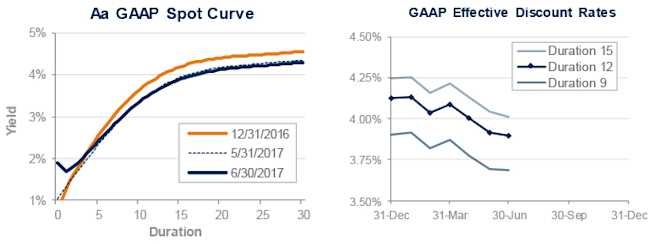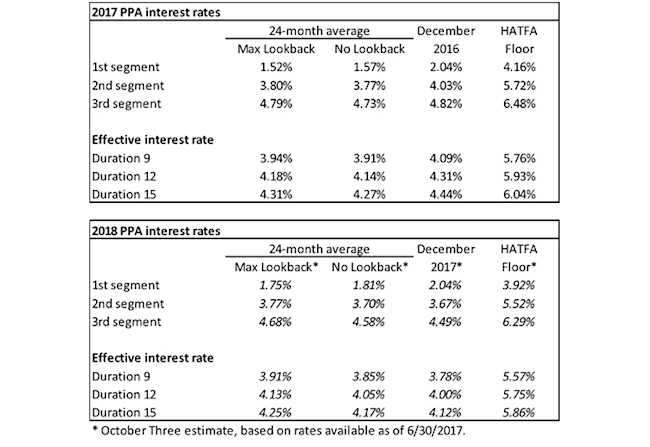June 2017 Pension Finance Update
Pension sponsors suffered modest declines in funded status last month, due to mixed stock markets and lower long-term interest rates, but both model plans we track1 have enjoyed modest improvement overall in the first half of 2017. Plan A lost close to 1% last month but is still ahead almost 2% for the year, while Plan B lost a fraction last month but is still up about a half percent during the first half of the year.

Assets
Stocks were mixed during June: the S&P 500 gained less than 1% and the small-cap Russell 2000 jumped more than 3%, but the NASDAQ and overseas EAFE indexes both lost 1% last month. For the year, the NASDAQ is 15% ahead, the S&P 500 is up almost 9%, the Russell 2000 is up 5%, and the EAFE index is up 14%.
A diversified stock portfolio gained less than 1% in June – the eighth consecutive month of positive stock market returns – and is now up more than 10% through the first half of 2017.
Bonds gained a fraction of 1% in June as long-term interest rates moved a bit lower. For the year, bonds are up 3%-5%, with longer duration bonds and corporates doing best.
Overall, our traditional 60/40 portfolio gained a fraction of 1% in June and is now up 7% for the year, while the conservative 20/80 portfolio was also up fractionally last month and is now almost 5% ahead during 2017.
Liabilities
Pension liabilities (for funding, accounting, and de-risking purposes) are now driven by market interest rates. The graph on the left compares our Aa GAAP spot yield curve at December 31, 2016, and June 30, 2017, and also shows the movement in the curve last month. The graph on the right shows our estimate of movements in effective GAAP discount rates for pension obligations of various durations during 2017:

Long-term yields moved down a couple basis points during June and are now about 0.25% lower than where they ended 2016.
The move pushed pension liabilities up less than 1% in June, leaving liabilities about 4%-6% higher during 2017, with long duration plans seeing the biggest increases.
Summary
Strong stock markets and lower interest rates have pushed both pension assets and liabilities up during the first half of 2017, with asset growth outpacing liability growth modestly.
The graphs below show the movement of assets and liabilities for our two model plans during the first half of 2017:

Looking Ahead
Congress passed a budget in 2015 that includes a third round of pension funding relief since 2012. The upshot is that pension funding requirements over the next several years will not be appreciably affected by current low interest rates (unless these rates persist). Required contributions for the next few years will be lower and more stable than under prior law.
Discount rates moved down a couple basis points last month. We expect most pension sponsors will use effective discount rates in the 3.6%-4.1% range to measure pension liabilities right now.
The table below summarizes rates that plan sponsors are required to use for IRS funding purposes for 2017, along with estimates for 2018. Pre-relief, both 24-month averages and December ‘spot’ rates, which are still required for some calculations, such as PBGC premiums, are also included.

1Plan A is a traditional plan (duration 12 at 5.5%) with a 60/40 asset allocation, while Plan B is a cash balance plan (duration 9 at 5.5%) with a 20/80 allocation with a greater emphasis on corporate and long-duration bonds. We assume overhead expenses of 1% of plan assets per year, and we assume the plans are 100% funded at the beginning of the year and ignore benefit accruals, contributions, and benefit payments in order to isolate the financial performance of plan assets versus liabilities.
